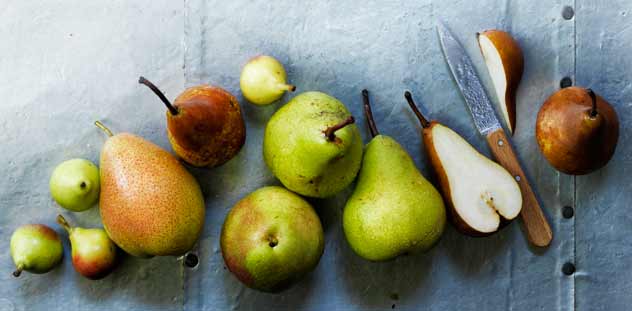How To With Pears. When you’re looking for superfoods, it’s hard to go past the humble pear. Beneath its waxy skin is a treasure trove of goodness that is essential for our digestive systems- and the fruit’s benefits are actually greatest if you eat it raw.
NUTRITION FACTOR
Pears are full of fibre and low in calories. They’re also fat-free, cholesterol-free and made up of mostly water (approximately 83 per cent of the fruit is water). The rest of the fruit is a combination of cellulose (dietary fibre), vitamins, carbs, minerals and trace elements. An average pear contains about 450 kilojoules of energy, and provides 18 per cent of your daily fibre quota. The fibre found in pears is an ‘insoluble polysaccharide’, which acts as a bulking agent in the intestines and binds to other waste as it passes through your system. This fibre also stimulates secretion of gastric juices and digestive enzymes, which is very important to overall gut health Pears also contain high amounts of polyphenolics, which help to fight the inflammation caused by bad diets and lifestyles. Along with high levels of vitamin C – an antioxidant with cancer-fighting properties – pears have a high quotient of vitamins A, K and B too. They’re also full of elements like calcium, copper, iron, manganese, magnesium and potassium. All of this goodness helps to boost immunity, reduce the risk of stroke and heart disease, prevent anaemia, and even deter dermatitis.
DID YOU KNOW?
Nutrients, flavour compounds and pigments found in fruits are often sensitive to heat, and can be broken down and reduced easily when cooked or frozen. Pears are no exception, and will degenerate quickly when heated. The natural sugars and carbohydrates will concentrate to create a sweeter product, but often at the expense of the huge nutritional benefits.
HOW TO BUY
Pears for large-scale supply are picked about two weeks before they’re ripe, and are then chilled for storage. When buying, check the firmness and the aroma of the pear, and make sure there aren’t any deep bruises or gashes in the fruit you are selecting. Some pear varieties, such as the popular brown-skinned beurre bosc, are better selected when they are erring on the slightly soft side – this means the fruit will be ripe and succulent. Other pears, such as Winter Nelis or Packham’s Triumph, are better to be chosen when they’re still hard and crisp.
HOW TO GROW
Pear trees are deep-rooted and medium to large in size, and they require a considered approach to planting. They are long-living trees – with some specimens existing for over 200 years and still producing fruit. Grown in temperature areas, they prefer full sun and well-draining soil. Most pear trees are not self-pollinating, so they usually also require another pear tree grown close by as a pollinator for better fruit production.
HOW TO STORE
Pears are best kept at room temperature, well separated and with their stems up, until they turn yellow and lose some of their firmness. Chill only to slow down ripening. They don’t need plastic wrapping or long stays in the fridge. Like most fruits the pear
is mostly water, and too long in the fridge will dry them out.
REDUCE WASTE
To reduce waste, buy pears in small batches and handle gently. Ripe, juicy pears should be eaten immediately, or cooked without delay before the fruit flies, mould and/or rotting sets in. If you’ve got a large amount of pears opt out of freezing, as the flesh doesn’t thaw well. Instead, try bottling in a light sugar syrup to preserve for long periods of time. You can also easily dehydrate pear slices to eat later.
COOKING WITH PEARS
The crunch of a pear is a lovely thing. At the perfect ripeness it can be firm yet soft, sweet yet tangy. A great idea is to add thin slices to salads. To keep peeled pears from turning dark, rub them with lemon juice or dip them into acidulated water.
COOK’S TIP
While the pear’s skin is great for eating raw, it can become tough and bitter when heated. Therefore make sure you peel your pears before cooking them. You should also keep the skins and cores of your pears in the freezer for later use. They are full of valuable pectin, which can be used to thicken your sauces, jams and jellies




